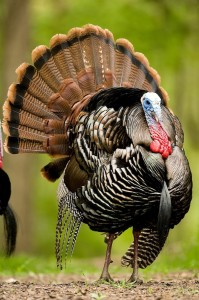
Photo courtesy of Missouri Department of Conservation
Legend has it that the turkey was founding father Benjamin Franklin’s preference for our national bird. In a letter to his daughter, he derided the bald eagle as “of bad moral Character”, and praised the turkey as “withal a true original Native of America… He is besides, though a little vain & silly, a Bird of Courage, and would not hesitate to attack a Grenadier of the British Guards who should presume to invade his Farm Yard with a red Coat on.”
He was certainly right about the native part, as turkeys originated in North America. And during the spring mating season, the males are perhaps a little vain and silly.
But the courageous part, according to resource scientist Jason Isabelle of the Missouri Department of Conservation, was probably wishful thinking on Franklin’s part. Turkeys are “incredibly cautious.” They are not fighters—their instinct is flight. That flight instinct is what makes them so challenging to hunt, because if they sense any threat they will just run or fly away. Since they can move on the ground at about 12 mph, they make it hard for the hunter to get off a shot. They can also fly for short distances, mainly to the trees where they roost at night.
A host of enemies
Turkeys have good reason to be cautious because predators abound. Coyotes, bobcats, great horned owls, red-tailed hawks, and even snakes (who eat the eggs) threaten their survival.

Photo courtesy of National Wild Turkey Federation
According to Isabelle, mostly because of their daytime ground dwelling habits, any turkey that hatches out of an egg has only about a 40% chance of surviving its first month. The hen will make her nest on the ground in thick vegetation. She will lay one egg a day for about ten days, and then has to sit on the nest for 28 days. Hatchlings, called “poults”, do not fly at first and are attractive to both winged and legged predators.
Poults are also susceptible to weather, and can die of hypothermia in heavy rain. In fact, the urban legend that turkeys can drown by trying to catch raindrops in their beaks may stem from this fact, theorizes urban naturalist Erin Shank of the Missouri Conservation Department
Turkey hens won’t defend their nests. If a coyote comes hunting, the hen will try to run or fly away. Sometimes the predator will get both eggs and egg layer, but if the hen survives she may nest a second time.
Of course there are exceptions to every rule, even the skittish turkey description. Shank tells of a call to south county where an exceptionally bold young male would chase children as they got off their school bus. He would advance and retreat, advance and retreat. “I saw it myself,” she says. She suspects this bird had been fed at somebody’s back door.
Turkey populations restored
Nowadays turkeys are becoming more common in urban areas. Flocks have even been seen in the St. Louis central west end, and a large number live in Calvary Cemetery. Today wild turkeys number 3-500,000 statewide depending upon the season.

Photo from MO Dept of Conservation
It was not always so. In the 1950’s, Missouri had only about 3000 turkeys in remote Ozark woods. They had been over-harvested by hunters. Add to that destruction of habitat as woods were burned or logged and turned into pasture, and the turkey had become a rare bird indeed.
The state closed the turkey hunting season in 1938. In the 1950’s, the Department of Conservation decided to find out if habitat improvement could increase turkey numbers. Wild turkeys could be bred on farms, but simply did not have the survival skills to make it in the wild. The department bought the large Peck Ranch in the southern Ozarks, and in that 11,000 acre tract protected the birds and provided food and cover. From 1951 to 1957 the population increased from 9 to 100.
With 100 birds, it seemed feasible to try to restore wild turkeys to other parts of the state where they had once flourished. An ingenious trapping method was devised, and groups of turkeys with a ratio of two hens to each Tom could be distributed. This video on the history of wild turkeys in Missouri shows the trapping method and some great footage of Tom turkeys strutting in all their glory:
New habitats would need to be cultivated in the same manner as at Peck ranch. The Conservation Department started an outreach program to persuade the people in the targeted area to do such things as leave some grain in the field, leave some cover, and report poaching. Missourians responded enthusiastically. Current wild turkey population numbers speak for the degree of enthusiasm.
Hunting began on a limited basis in 1960, and served to stir up more excitement about the wild turkey. Today there are both spring and autumn hunting seasons, and each of Missouri’s 114 counties has areas where hunting is permitted.
Whereas wildlife biologists once thought that turkeys could thrive only in wooded areas, research has shown that they are generalists. They do like acorns, but they also like beans, corn, and other vegetatable matter. Poults live mainly on insects. The ideal turkey habitat seems to be 50% woods and 50% open fields.
Citizen involvement in wildlife restoration
The continuing efforts to restore habitats and animal populations owe a great deal to the value Missouri voters have placed on conservation.

Photo from MO Dept. of Conservation
In 1976 voters passed a 1/8 cent sales tax to be used solely for conservation. The collected monies have been used to purchase new natural areas, for managing over a million acres of public land, for research, and for education and outreach. A division called private land services works with landowners to set up a plan to manage their property and meet their wildlife habitat goals. Missouri is one of only three states to have such a dedicated tax. Arkansas and Minnesota are the others.
A last word on the wild turkey at Thanksgiving time. Jason Isabelle says he will have one on his table. They are delicious, he says, although a bit different in flavor from domestic birds. And, of course, the Conservation Department will provide you with recipes in the “Cooking wild in Missouri” publication.
This article was originally published in the St. Louis Beacon.
